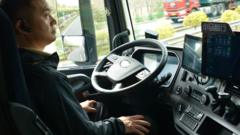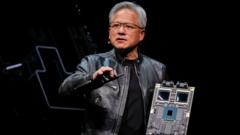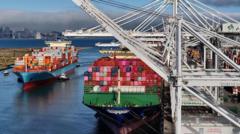With successful trial runs showcasing self-driving trucks between major cities like Beijing and Tianjin, China's transport industry is on the brink of transformation. However, while the technology holds great promise for efficiency and reduced costs, public perception and safety concerns remain critical hurdles.
Driverless Trucks: The Future of Transportation in China

Driverless Trucks: The Future of Transportation in China
As China embraces autonomous technology, its driverless lorries are set to revolutionize the transport sector despite challenges ahead.
On the highways connecting Beijing and Tianjin, a fleet of driverless trucks is navigating its way into the future of Chinese transportation. These autonomous lorries are not just an experiment; they are the beginning of a transformation that may reshape logistics across the nation. While human safety drivers remain in the passenger seat as mandated by regulations, many industry analysts predict that full autonomy could soon replace them entirely.
Safety driver Huo Kangtian, 32, recounts his first experience allowing the truck to drive without his hands on the wheel. "It was both impressive and unsettling," he admits. Initially conducting his duties with full control, he is amazed when he activates the self-driving feature, allowing the heavy vehicle to accelerate down public roads smoothly. "After extensive observation and testing, I find them quite safe," Mr. Huo emphasizes, noting that stepping into autonomous mode can significantly alleviate stress and fatigue arising from long hauls.
Pony AI's Vice-President, Li Hengyu, envisions a future with fully autonomous operations, which he believes will enhance transportation efficiency while lowering labor costs. "We can better manage harsh environments and long hours of driving," he states confidently. Expert analysis from Yang Ruigang, a technology professor at Shanghai Jiaotong University, echoes this sentiment, highlighting the cost-saving advantages that autonomous trucks present to companies. This investment, he asserts, is justified by the potential to "reduce the driver cost close to zero."
Nevertheless, the path to widespread acceptance of autonomous trucks is fraught with challenges, particularly concerning public trust. Following a disastrous accident involving a self-driving vehicle that claimed three lives, skepticism regarding driverless technology remains prevalent. Economist Intelligence Unit analyst Chim Lee notes, "The public reaction to recent car accidents will be critical when it comes to the acceptance of driverless trucks."
The reality is that while many experts agree that truck drivers' jobs won’t disappear en masse just yet, they predict certain niches for autonomy, particularly in low-speed environments. In Hefei, a city in Eastern China, driverless delivery vans have already taken to the roads, optimizing logistics by assisting human drivers in efficient package drop-offs. Rino.ai's president, Gary Huang, illustrates how these vehicles bridge the gap between distribution centers and neighborhoods, indicating the potential for driverless technology to boost overall system efficiency.
China remains enthusiastic about advancing such technologies, with Rino's regional director, Zhang Qichen, emphasizing that autonomous delivery vans are running on roads in over 50 cities. Yet, Hefei showcases the most advanced trial of autonomous vehicles, with supportive local government policies facilitating this rapid change.
Despite the excitement, technical challenges still loom large for driverless lorries, including the need for better sensors and cameras to navigate complex environments safely. The current prototypes are often modifications of traditional trucks rather than newly produced self-driving models, adding another layer of complexity.
Ultimately, the success of the driverless truck initiative will hinge not only on technological advancements and regulatory frameworks but also on the public's perception of safety and reliability. As experts reflect on the future, Professor Yang notes the importance of instilling confidence, as society's tolerance for errors made by machines is notably lower than that of human drivers.
In summary, while China is eager to champion advancements in transportation through autonomous vehicles, fostering public trust and ensuring flawless operation will be critical for realizing the full potential of driverless technology on the roads.

















